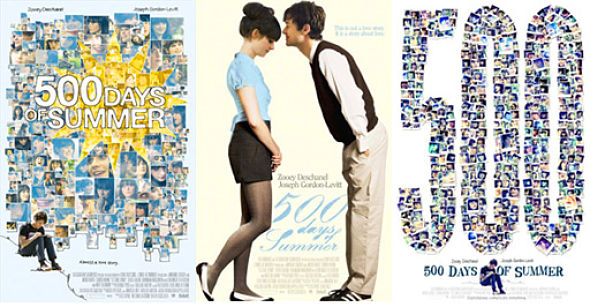Circular narrative - The
film opens with the two main characters, being Summer and Tom sat on a bench
over looking the city. This scene is the same scene that is shown at the en of
the film, so the story loops back round full circle within 95 minutes, ending
at the same point it started.
The film starts on day 488, then goes back to day 1, by the
time the film ends it loops back round
to day 488, where the film started.
The film jumps from day to day throughout but I noticed that
the days didn't go in order, they sometimes jumped like 200 days and then went
back nearly the same amount in the next scene, there was no consistency. I
noticed that it tended to jump from happy to sad quite often though.
The story tells us of how the two of them met, the happiness
and the heartbreak that happens. I really like the way the film is put
together. It has kept me interested and drawn in every time I have watched it.
The way it jumps days keeps you interested and you want to know what has happened
previously (as it has jumped a certain amount of days) to see how they have
come to the point you are seeing. Its like seeing the future before the past or
present.
Inception
Inception has a circular narrative where the first scene in the film starts the story off - being a dream and then by the end of the film you see the same scene again where it is again a dream only this time its more explanatory.
After watching inception I was just as confused as I was at the beginning, the film is so so deep with loads of different layers. It's a dream within a dream within a dream, and I was never really 100% sure what was happening and it something was in fact reality or just a dream.
Maroon 5 - Payphone music video
The music video for pay phone by maroon 5 has a circular narrative, the video starts with the lead singer and main character in the video (Adam Levine) stood in a payphone in the middle of no where, a story is then told about how he got to that payphone and the events that took place to bring him there, the video then goes full circle and ends at that same payphone where the video started.
Eternal Sunshine of the spotless mind
This film has a pretty strange concept. Its constantly jumping from present day to the past, it actually confused me a little bit at some points as I was too sure what time period I was watching, but at the end of the film everything came together and made complete sense. This film has a circular narrative and it starts at the same point we wind up at seeing at the end of the film.
Inception
Inception has a circular narrative where the first scene in the film starts the story off - being a dream and then by the end of the film you see the same scene again where it is again a dream only this time its more explanatory.
After watching inception I was just as confused as I was at the beginning, the film is so so deep with loads of different layers. It's a dream within a dream within a dream, and I was never really 100% sure what was happening and it something was in fact reality or just a dream.
Maroon 5 - Payphone music video
The music video for pay phone by maroon 5 has a circular narrative, the video starts with the lead singer and main character in the video (Adam Levine) stood in a payphone in the middle of no where, a story is then told about how he got to that payphone and the events that took place to bring him there, the video then goes full circle and ends at that same payphone where the video started.
Eternal Sunshine of the spotless mind
This film has a pretty strange concept. Its constantly jumping from present day to the past, it actually confused me a little bit at some points as I was too sure what time period I was watching, but at the end of the film everything came together and made complete sense. This film has a circular narrative and it starts at the same point we wind up at seeing at the end of the film.


























